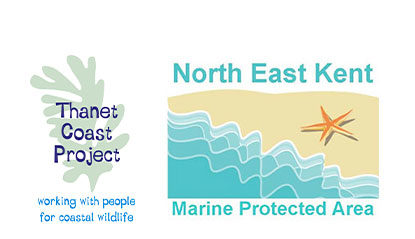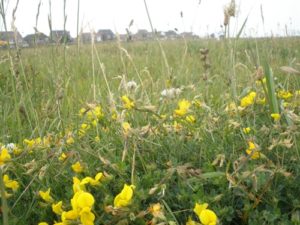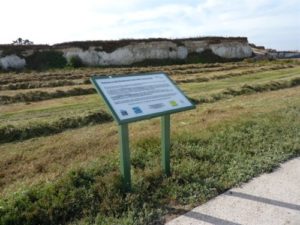Making a Buzz for the Coast – Project Outline
Delivery phase 1 October 2017 to 30 Sept 2020 (extended to 31 March 2021)
Making a Buzz for the Coast is an ambitious natural heritage project which spans 135 miles of coastline from Dartford to Deal and focuses on North and East Kent’s wild pollinator populations, especially bumblebees and solitary bees. The project is led by the Bumblebee Conservation Trust (BBCT) in partnership with Kent Wildlife Trust, Kent County Council, Natural England and the RSPB – with support from the Heritage Lottery Fund.
Making a Buzz for the Coast will secure a future for the Kent coast’s wild bees in which they not just survive but thrive. The Bumblebee Conservation Trust will do this by mobilising the people of Kent to take action to protect their wild bees; building a greater understanding of bee populations; and creating habitats for some of our rarest bumblebees.
The project aims to protect and enhance Kent’s wild pollinator populations through habitat provision, monitoring populations, and awareness raising. The project is divided into three themes:
- Providing habitat – Provide habitat for Kent’s wild bees, with particular focus on priority species including the Shrill carder bee – the UK’s rarest and most threatened bumblebee species.
- Understanding populations – Monitor bumblebee populations in order to guide our conservation work.
- Engaging communities – Raise awareness about bumblebees and other pollinators, the benefits they provide and what can be done to help them, inspiring individual action.
Why Kent?
Kent’s cultural and economic heritage is intrinsically linked to bees. With its rolling landscapes which give rise to a long tradition of fruit production and horticulture, Kent is heavily reliant on bees and the pollination services they provide. Declines in wild pollinator populations over recent decades have led to a pollination deficit which negatively impacts on yields as well as fruit or seed quality. Furthermore, bees are fundamental to ecosystem functioning in a diverse range of habitats and bee declines have been linked to decreases in floristic diversity and wider biodiversity losses.
The Kent coast is a hotspot for rare bumblebees such as the Shrill carder bee Bombus sylvarum (the UK’s most threatened bumblebee), Brown-banded carder bee Bombus humilis and Moss carder bee Bombus muscorum, (all priority species under Section 41, NERC Act 2006) as well as several rare solitary bees such as the sea aster mining bee Colletes halophilus. These species exist in small, isolated and fragmented populations along the coast which leads to inbreeding and a reduction in genetic diversity, making populations even more vulnerable. One of the primary aims of Making a Buzz for the Coast will be to safeguard these rare bee populations by creating and restoring habitat in existing population centres and linking isolated populations through the creation of flower-rich ‘stepping stones’ and habitat corridors along the coast.
The project will act as a flagship initiative within the National Pollinator Strategy and will help to deliver Kent County Council’s ‘Plan Bee’ aimed at mobilising the people of Kent to take action to help pollinators.
The three project themes will be delivered through seven interlinking work strands:
Strand 1 – Habitat Works and Practical Conservation: We will work with the RSPB, Thanet District Council and Thames Water on five sites to increase habitat for priority bumblebees and solitary bees. Habitat works will include grassland restoration; sowing wildflowers to increase forage; adjustment of cutting and grazing regimes; rotational scrub management; creation of solitary bee nest sites. We will install interpretation boards to raise awareness and knowledge of local bee species.
Strand 2 – Bee-Roads: This strand will be led by Kent Wildlife Trust and will restore 14 roadside verges in Swale into flower-rich habitats for bees and other wild pollinators, and provide habitat connectivity, in partnership with KCC Highways and Swale Borough Council.
Strand 3 – Landowner Engagement and Advice: We will provide specialist land management advice to a range of landowners including farmers, fruit producers, holiday parks, golf courses, smallholders and parish councils to help them restore and create bee-friendly habitat along the coast, working closely with Natural England.
Strand 4 – Bee With Us: This is the central hub of the project: the recruitment, training and supporting of volunteers, who will play a vital role in all seven work strands. In addition, the project will host three volunteer trainee placements per year for those pursuing a career in conservation: Conservation Trainee, Bumblebee Monitoring Trainee and Bee-Roads Trainee.
Strand 5 – Skills for Bees: We will recruit and train volunteers to undertake regular bumblebee surveys as part of BBCT’s national recording scheme, BeeWalk, monitoring population densities of rare and common bumblebees along the coast. This strand aims to build a new generation of bumblebee experts in Kent through a staged training programme (beginners to advanced), a mentoring scheme and ongoing support to help volunteers and ensure all data are verified.
Strand 6 – Buzzing Communities: We will work with local communities, schools and businesses to help people learn about and take action for bees, raising awareness about their importance through guided walks, talks, a ‘Buzzing schools’ competition (in partnership with KCC), community competitions (gardening, photography, art and poetry), a range of factsheets, exhibits and a quarterly e-newsletter.
Strand 7 – Buzzing Gardens: This strand will highlight the importance of gardens for bees and other pollinators and help people (individuals, schools, community groups, local businesses, and councils) to garden for bees. We will deliver a range of events and, working with Kent Wildlife Trust, we will train a team of volunteer garden advisers and run an annual Garden with Best Buzz competition as part of KWT’s Wild About Gardens scheme.
On the Thanet Coast, there are two chalk grassland/cliff edge sites that will be managed in partnership between Thanet Council and the Bumblebee Conservation Trust with the help of volunteers (‘friends of’ groups) under this project: at 1) Foreness Point to Botany bay; and 2) Westbrook.
More information:
Case Study: Foreness Point (2021 PDF, 3MB)
Interpretation panel: The Wildlife of Foreness Point (PDF, 2MB 2020)
Case Study: Westbrook Sunken Gardens (2021 PDF, 2MB)
Interpretation Panel: Bumblebee Friendly Gardening at the Sunken Gardens Westbrook (PDF, 3.7MB)
Website: Making a Buzz for the Coast & Bumblebee Conservation Trust
Tasks: 2017-21 BBCT tasks have now been completed, but management is ongoing
Online – BBCT Bumblebee Identification & other training completed
Work Tasks: Westbrook Sunken Garden, Westgate – set up in 2018 to help restore and maintain the sunken garden site at Westbrook and increase the plants to attract morebumblebees. Further information: Westbrook Sunken Garden Society.
Previous practical work tasks have included:
Foreness grassland cutting (temp.sign sample 2020)
Yellow rattle sowing/Clean up – 11 Dec 2018 – Westbrook Undercliff
Grassland Cuts – July & October 2018 – cut & remove arisings to reduce nutrients and increase diversity of the grassland flora as this grassland has been losing its biodiversity.
Work Party: Westbrook Undercliff, Margate – tree planting/litter pick 24 Feb 2018
Treatment of Alexanders – Feb 2018 Alexanders (Smyrnium olusatrum) at Botany Bay to Foreness & Westbrook undercliff grassland
Presentation: Making a Buzz for the Coast – intro (24 Jan 2018 BBCT) Margate VIC



